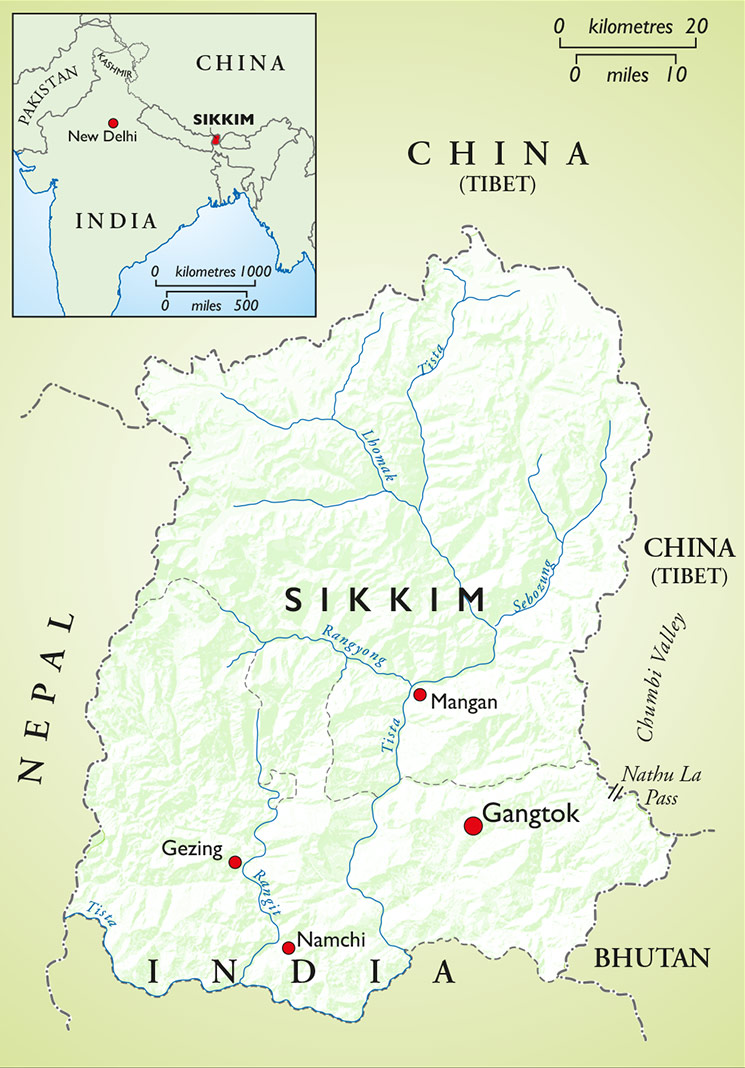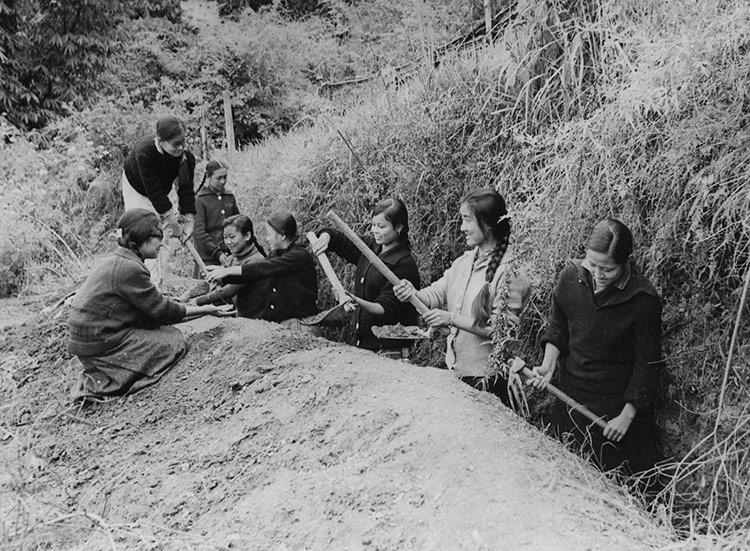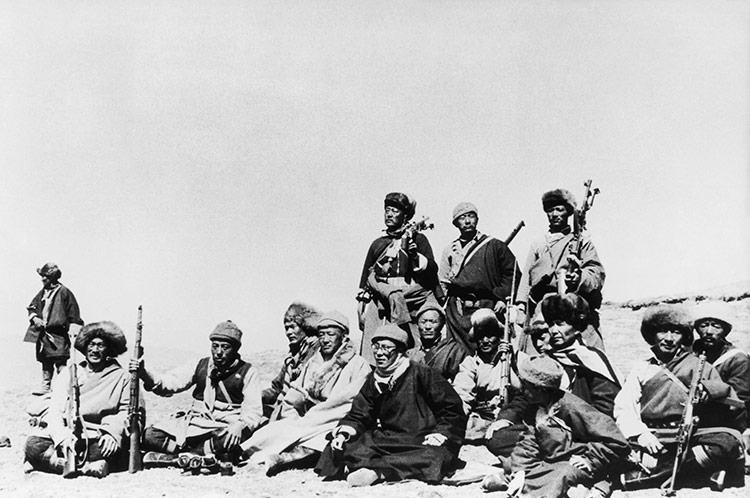cultură şi spiritualitate
When India and Pakistan gained independence from Britain in 1947, the region’s Princely States – including tiny Sikkim – became pawns in South Asia’s great power politics, as Andrew Duff explains.
At the height of the Indo-Pakistan war, in mid-September 1965, Britain’s ITN broadcast a 15-minute report from what they called ‘another potential starting point for a Third World War’. The images were not of Indian and Pakistani soldiers in disputed Kashmir. Instead, the dramatic footage showed Indian and Chinese soldiers 14,000 feet up on the other side of the Himalayas, on either side of the border between the Kingdom of Sikkim (an Indian protectorate perched between Nepal and Bhutan) and Chinese-occupied Tibet.
The broadcast highlights an often-overlooked international dimension to the 1965 conflict, which caused frantic diplomatic activity involving India, Pakistan, China, the US and the Soviet Union and was, in fact, an important factor in the eventual de-escalation of the crisis.

Kashmir, the largest of the 600 Princely States of British India, which became the main theatre of the 1965 war between India and Pakistan, had been a running sore between the two countries for nearly two decades. At Partition in 1947 the question of the Princely States’ future loomed large. All ran their own affairs under individual agreements with the British. Official policy was to allow the ruler of each to determine whether the Princely State would join India or Pakistan. For most it was a simple decision. For Kashmir, it was not. The Hindu Maharaja, Hari Singh, ruled a majority Muslim population. India’s leaders presumed Singh would decide to join India. Pakistan’s leaders argued that the Muslim population should join Pakistan. Singh, fearing the socialist Nehru’s India almost as much as he did the prospect of joining Jinnah’s Pakistan, considered a third option: asserting independence, harbouring dreams of creating a Switzerland of Asia.
Reality jolted Singh out of his reverie. When Kashmiri Muslims began to flee to Pakistan (principally to avoid punitive taxes), Pakistani Pathans crossed back into Kashmir to ‘liberate’ its people from their Hindu ruler. A bloody conflict broke out. Nehru sent military support to Singh – on the condition that he accede to India.
The Indians sought to internationalise the issue, taking it to the newly formed United Nations in early 1948. The UN commission to New Delhi and Karachi advocated a plebiscite in Kashmir. As the fighting continued, relations between Pakistan and India deteriorated. Positions became entrenched. Nehru (whose family originated from Kashmir) reneged on the idea of a plebiscite. The Kashmir operation was vital to prove the subcontinent could rise above communalism. It was, he said, ‘a fight for the freedom of India’.
***
Afragile UN-promoted ceasefire line in 1949 left India in control of the lion’s share of the state, including the vital ‘Vale of Kashmir’. Pakistan settled in to its position as the aggrieved party. As Pakistan and India found their feet during the 1950s, the Kashmir issue festered in the background.
Meanwhile, to the north, the People’s Republic of China was consolidating its de factocontrol of Tibet, which it had invaded in 1950. Nehru dreamed of a Pan-Asian entente between China and India. But after the Dalai Lama’s flight to India in 1959, such hopes faded. Worried by such developments, the Indians attempted to assert control in two disputed areas of the Sino-Indian border. The result was the short, sharp 1962 Sino-Indian conflict. The Chinese, who had repulsed Indian advances and moved deep into Indian territory, were regarded as victors.
Pakistan’s new president, Ayub Khan, who had assumed power in a coup in 1959, watched these developments with interest. India’s military had appeared unprepared and blundering during the 1962 war. Khan and his new foreign minister, Zulfikar Ali Bhutto, sensed an opportunity to enlist Chinese support in pushing their claims in Kashmir.
The ageing Nehru, desperate to leave a positive legacy for Kashmir, agreed to negotiations with Pakistan; historians have often pondered the counterfactual question: what would have happened if Nehru’s death had not cut short negotiations in June 1964?
With the inexperienced Lal Bahadur Shastri at the helm in India and with the developing relationship between Pakistan and India as a backdrop, in late 1964 Foreign Minister Bhutto stated that ‘Kashmir is to Pakistan what Berlin is to the West’. It was deliberately provocative. Meanwhile, he prepared plans for Pakistani tanks to roll into the Rann of Kutch, an unremarkable expanse of salt marshes at the southern extremity of the border with India. Pakistan got the better of the tank skirmishes between April and June 1965. Bhutto then put forward plans to Ayub for ‘Operation Gibraltar’, an infiltration of Kashmir in August 1965, with which the serious fighting began.
 Children from the Paljor Namgyal Girls’ School dig trenches against Chinese attack, October 1965.
Children from the Paljor Namgyal Girls’ School dig trenches against Chinese attack, October 1965.
Curiously, some of the 1965 battles involved US-made Patton tanks (sold to the Pakistanis) firing on American Sherman tanks (sold largely to the Indians). Cold War arms sales to South Asia had grown massively after the Sino-Indian war, which had coincided with the Cuban missile crisis. At the height of the twin 1962 crises, President Kennedy, fearing a two-front global war against Communism, had sent the carrier USS Enterprise to the Bay of Bengal. Further arms sales followed the resolution of the conflict. In November Kennedy stated that ‘all our aid to India is for the purpose of defeating Chinese communist subversion’. Sales to Pakistan also flowed, but more slowly. It was another reason why Ayub, who felt Pakistan had loyally supported the US anti-communist effort since the mid-1950s, had tilted his allegiance towards China.
When the main Indo-Pakistan conflict broke out in August 1965, Bhutto, who was increasingly leading the Pakistani decision-making, hoped that Chinese pressure, real or imagined, might squeeze Indian confidence.
Kashmir was not the only Princely State that had sought a different future in 1947. Nepal, Bhutan and, squeezed in between the two, the Kingdom of Sikkim all had specific agreements with British India and, therefore, put forward arguments for special treatment. While Nepal’s independence was a foregone conclusion, the cases of Bhutan and Sikkim, whose rulers came from related families, were more complicated.
Bhutan, at least, had signed a formal agreement with British India in 1910. A protectorate arrangement signed in 1949 was a formality. Sikkim proved more problematic. The state, one sixth the size of Bhutan, lay along the Chumbi Valley in the Himalayas, which had served as a principal trading route for centuries. Its Buddhist ruling family had migrated from Tibet in the early 17th century. The British, recognising in the 19th century that Sikkim was a key access point for Tibet, slowly brought the state’s ruling family into the fold of Empire. Although various agreements were signed, none clarified the exact relationship between British India and Sikkim. Nevertheless, Sikkim emerged with a treaty with India in 1950 that gave it an international personality of sorts, albeit with highly
limited powers.
***
During the 1950s Crown Prince Thondup Namgyal set about reforming the administration in Sikkim. But events in Tibet loomed large. Soon the state became a base for a secretive CIA operation supporting Tibetan guerillas. Thondup and his glamorous sisters, Coocoola and Kula, became involved, even running messages between the Americans and the young Dalai Lama’s Tibetan leadership. The dramatic 1959 flight of the Dalai Lama highlighted Sikkim’s vulnerability. The Chumbi Valley was now, Nehru claimed, a Chinese-occupied ‘dagger pointed at the heart of India’. Although Sikkim was never under serious threat during the 1962 Sino-Indian war, Indian troops arrived in numbers.
 The 14th Dalai Lama (front, in black) flees Tibet for India with his Khamba warrior guards, 1959.
The 14th Dalai Lama (front, in black) flees Tibet for India with his Khamba warrior guards, 1959.
There had been another critical development in Sikkim in 1959. The Crown Prince, widowed in 1957 at the age of 34 with three young children, fell in love with a willowy 19-year-old US debutante, Hope Cooke. Their 1963 marriage thrust Sikkim onto the international stage. The American press christened Cooke ‘the Grace Kelly of the East’. Both Paris Match and National Geographic tripped over each other to cover the couple’s lavish wedding, which was an extraordinary clash of cultures: ‘Guests in top hats and cutaways mingled with others in fur-flapped caps and knee-length yak-skin boots,’ fawned Time magazine. J.K. Galbraith, the US ambassador to India, was seen doing the twist with Princess Coocoola.
For India, these developments in Sikkim were less welcome. Some questioned why the young American had suddenly appeared in geopolitically sensitive Sikkim. Hope Cooke’s uncle had been US ambassador in Iran during the turbulent 1950s. There were allegations that she had connections to the CIA. It did not help when, at their coronation in April 1965, Thondup Namgyal and Hope Cooke announced that they would be using the ancient Sikkimese titles of Chogyal and Gyalmo. In an Indian republic not yet two decades old, such assertions of separate identity and monarchical rule were bound to raise questions.
In early September 1965, when the fighting in Kashmir was at its fiercest, China moved 5,000 troops into the Chumbi Valley, alleging that the Indians had been violating the border between Sikkim and Chinese-occupied Tibet.
The Indians were greatly concerned. The fact that Pakistan had an eastern wing (later to become Bangladesh) already provided dual security challenges. The build-up on the Sikkim border raised the nightmare prospect of a two- (or even three-) front war.
The US was also worried by the thought of a Chinese intervention. President Johnson, ever deeper embroiled in Vietnam, was desperate to avoid an escalation of tensions in another part of Asia. Both Ayub for Pakistan and Shastri for India were in constant contact with US representatives, sometimes directly with Johnson in Washington. Meanwhile, the US ambassador in Delhi noted another complication: there were ‘Soviet SAMs protecting Delhi and other cities from attack by Pak MAP-procured B–57s, Soviet tanks fighting US tanks in Punjab and additional MIGs apparently on their way … the Soviets have already made deep inroads.’
***
The Chinese issued a three-day ultimatum to the Indians on September 16th, which raised the prospect of an attack on Sikkim. Ayub was quick to plead innocence of any collusion, claiming it was Bhutto who was leading the interactions with the Chinese. Shastri meanwhile asked the US to state that it would stand with the Indians in the face of Chinese aggression. L.K. Jha, a leading member of Shastri’s cabinet, even asked the US ambassador if Johnson ‘would be willing on strictly covert basis to authorise US personnel to consult with Indian military planners on contingency basis’. Johnson refused, but he was concerned at the magnitude of the escalating crisis. On September 18th, he commented to Arthur Goldberg, US ambassador to the UN, that India and Pakistan ‘just can’t afford to have this World War III ... They can’t have that kind of crime around their necks’.
That same day the Chinese extended the ultimatum by three days, buying crucial breathing space. In the files available on the US Department of State website, it is clear that Walter McConaughy, the doughty US ambassador to Pakistan, played a critical role in resolving the crisis. Despite an atmosphere of extreme paranoia in Pakistan, he managed to meet with a senior official on September 19th, without the usual attendant minders. Ayub, the official told him, was ‘strongly averse to entering any Chicom association and open to a sensible compromise way out’ and ‘growingly aware of Bhutto’s extremism’. Whether this was true or not, McConaughy skilfully conveyed the message that Pakistan would become an international pariah unless it de-escalated and agreed to the UN-proposed unconditional ceasefire (that India had already accepted). At the last possible moment Bhutto announced, at the UN, that it would do so. The climbdown had dire consequences in Pakistan, where the people had been led to believe – wrongly – that they were winning the war.
On the Sikkim-Tibet border, tensions were reduced. For the Sikkimese ruler, Thondup Namgyal and his American wife, however, something fundamental had changed. After Shastri collapsed of a heart attack at the Soviet-sponsored negotiations in January, Nehru’s daughter Indira Gandhi assumed the mantle of leadership in India. Thondup knew her well and harboured hopes of gaining a more secure future for his tiny kingdom. But clashes between Indian and Chinese troops on the Sikkim-Tibet border in 1967 and another war between India and Pakistan in 1971 – this time resulting in the eventual ‘liberation’ of Bangladesh (formerly East Pakistan) – further highlighted Sikkim’s vulnerability. Indira Gandhi, facing internal opposition and sceptical of the rapprochement between President Nixon and his Secretary of State Henry Kissinger and the Chinese leadership, moved on the tiny state in 1973. India’s intelligence services provided covert support for the democratic forces in Sikkim, forcing Thondup to relinquish much of his power. Cooke, still only 33, left for the US. Thondup clung on for a further two years but, on the eve of declaring an Emergency in June 1975, Indira Gandhi had the tiny palace in Sikkim surrounded, stripped Thondup and his family of any remaining power and annexed the state.
As the ITN broadcast of September 1965 said: ‘Small states are often pawns in the game of power politics and Sikkim … is one of the smallest and weakest states in Asia.’ The events on the Sino-Tibetan border in 1965 had a direct impact on the course of the Indo-Pakistan war. They also set the tone for India’s complex relationship with China in the Himalayas throughout the following decades.
Andrew Duff writes on India and related subjects and is the author of Sikkim: Requiem for a Himalayan Kingdom (Birlinn, 2015).
Adaugă un comentariu
© 2024 Created by altmarius.
Oferit de
![]()
Embleme | Raportare eroare | Termeni de utilizare a serviciilor













Pentru a putea adăuga comentarii trebuie să fii membru al altmarius !
Alătură-te reţelei altmarius